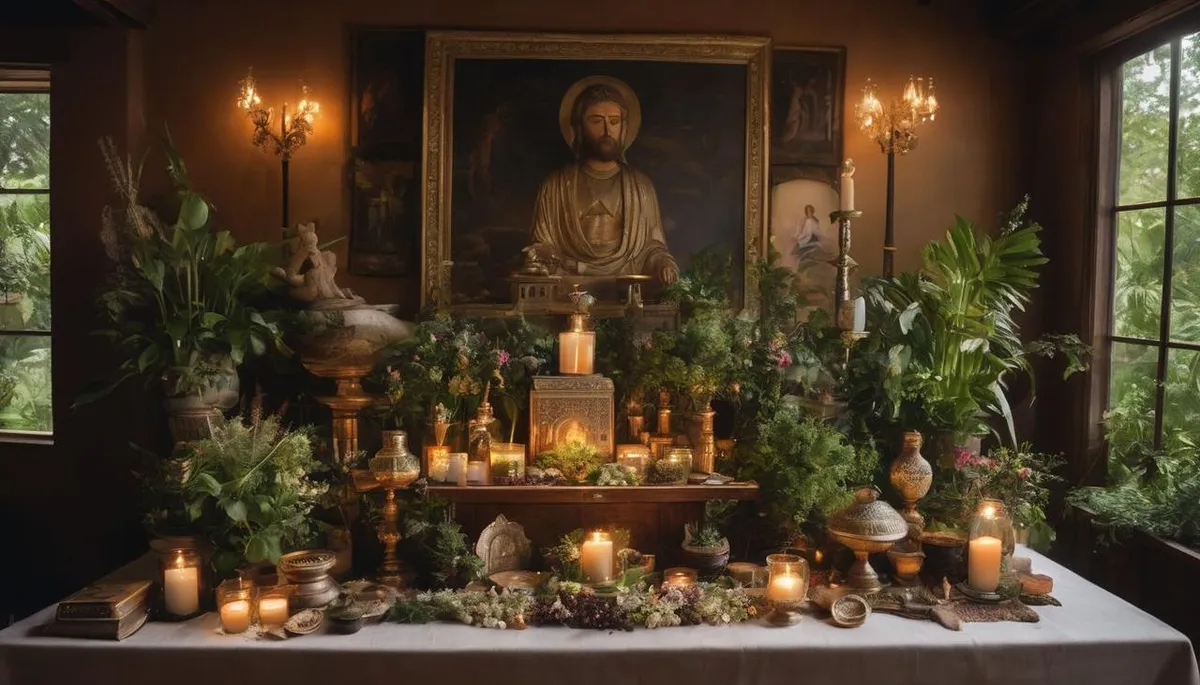
Planning a wedding is exciting, but combining different faiths can be tricky. Interfaith ceremonies are becoming more common, allowing couples from diverse backgrounds to honor their beliefs.
This article will guide you through creating a meaningful interfaith marriage ceremony that respects both traditions and celebrates your unique love story. Let's make magic happen.
Key Takeaways
- Plan your interfaith wedding early to discuss and blend traditions from both faiths with respect.
- Work closely with officiants who understand and honor different religious backgrounds.
- Include family members in the ceremony to show unity among all relatives.
- Create a unique symbol or ritual that celebrates the union of different cultures and beliefs.
- Educate guests about each tradition used in the ceremony for better understanding and appreciation.
What Is an Interfaith Wedding?
An interfaith wedding joins two people from different religious backgrounds in marriage. It celebrates both partners' faiths, respecting and understanding their unique traditions. This type of ceremony is legal for those of all beliefs or none, highlighting the importance of spiritual unity despite religious diversity. It is essential to understand the legal formalities for foreign marriages in bahrain to ensure a smooth process.
Couples planning an interfaith wedding work together to blend elements from each of their traditions into the celebration. They focus on creating a respectful and inclusive experience that honors the sacred vows from both sides.
Interfaith ministers often officiate these ceremonies, offering guidance to ensure that every aspect reflects the couple's shared values and respect for each other's beliefs.
How to Plan and Create a Meaningful Interfaith Marriage Ceremony
Plan and create a meaningful interfaith marriage ceremony by giving your engagement more time. Connect with your officiants ahead of time to incorporate traditions from both faiths.
Give your engagement more time
Allocate ample time to plan your interfaith marriage ceremony. Discuss with your partner the beliefs and traditions that are important to each of you. Communicate openly about how you envision these elements being incorporated into your wedding ceremony, ensuring mutual understanding and respect.
Take the time to research and understand the significance of different rituals and symbols from both faiths or cultural backgrounds that will be included in the ceremony. This thoughtful consideration will enrich the experience for both partners, creating a meaningful and inclusive celebration of your union, while also taking into account cultural preferences wedding rings.
Connect with your officiants ahead of time
Discuss your beliefs and ceremony expectations with the officiants well in advance. Ensure they understand the importance of blending traditions respectfully.
Interfaith ministers can offer valuable advice on creating a meaningful and inclusive ceremony that reflects both partners' beliefs and backgrounds while ensuring it is respectful to all involved.
Incorporate traditions from both faiths
Incorporate traditions from both faiths by blending meaningful elements such as wedding blessings, vows, or rituals that hold significance in each partner's faith. Ensure to openly communicate and respectfully consider the beliefs and customs of both families when selecting these traditions, including meaningful elements from both traditions.
Integrate inclusive rituals like lighting a unity candle or sharing cultural symbols to symbolize harmony and togetherness within the interfaith marriage ceremony. By doing so, you can create a rich tapestry of tradition that represents the love and commitment of both partners while honoring their individual heritage.
Craft a unique blend of customs from different backgrounds, religions, and cultures to create an inclusive experience for all participants involved in the interfaith wedding ceremony.
Include important family members
Involve both families in the ceremony by having them perform readings, blessings, or cultural rituals. This inclusion acknowledges and honors their support for your union. Acknowledge the importance of each family's religious or cultural practices in the ceremony to foster a sense of unity and understanding among everyone present.
Consider having family members participate in the lighting of unity candles, offering prayers, or sharing personal reflections to symbolize their love and support for your interfaith marriage.
This involvement can create a meaningful and inclusive experience that celebrates the blending of traditions within your families.
Create a lasting symbol of your interfaith union
Symbolize your interfaith union by crafting a unique unity ritual that combines traditions from both faiths, such as a tree planting ceremony or the mixing of colored sands. This symbolic act can represent the coming together of two different backgrounds in harmony and unity, creating a meaningful and inclusive experience for both partners and their families.
Incorporate elements from nature, like flowers or water, to represent the beauty of diversity within your interfaith marriage, ensuring that the symbol holds deep personal significance to both you and your partner.
Tips and Ideas for Interfaith Wedding Ceremonies
Enhance the ambiance by lighting a unity candle symbolizing your union. Add depth to your decor by incorporating both faiths' traditional elements.
Light a unity candle
Incorporate the unity candle tradition into your interfaith marriage ceremony. This ritual symbolizes the joining of two families and faiths. The couple lights a single candle together, representing their unity in marriage despite their individual backgrounds.
Use this beautiful tradition to signify the coming together of different beliefs while honoring each partner's heritage. Incorporating the lighting of a unity candle can serve as a powerful symbol of love and harmony, creating an unforgettable moment within your interfaith wedding ceremony that resonates with both families and guests.
Incorporate traditions into decor
Enhance the ambiance by incorporating traditional elements from both faiths into the decor. Use symbolic items such as a chuppah, floral arrangements, or cultural artifacts to represent each partner's heritage and create a harmonious blend of traditions.
Consider integrating meaningful colors, patterns, or motifs that hold significance in both faiths to visually symbolize the unity of the interfaith marriage.
Infuse the decor with reverence by displaying items that reflect the spiritual values and beliefs of both partners. Utilize sacred symbols, scriptures, or religious imagery tastefully throughout the venue to honor each tradition respectfully.
Include VIPs in all ceremonies
Ensure that important family members, such as parents and grandparents, actively participate in the ceremony. Incorporate meaningful roles for them, such as readings or blessings, to make them feel valued.
Invite close friends and relatives to share their thoughts and well-wishes during the ceremony; this fosters a sense of community and inclusivity among all attendees.
Educate guests about traditions
During the interfaith wedding ceremony, take a moment to explain the significance of each tradition. Provide program notes or have the officiant briefly describe each ritual before it is performed, helping guests of all backgrounds understand and appreciate the meaning behind them.
Educating guests about the traditions being incorporated into the ceremony can foster an atmosphere of inclusivity and understanding.
A meaningful way to educate guests about traditions is by using visual aids such as slideshows or displaying explanations next to relevant decorations. This will not only enhance their experience but also create an opportunity for everyone present to share in the beauty and diversity of different faiths coming together in unity.
FAQs about Interfaith Weddings and Choosing an Officiant
Do interfaith weddings have to be religious? Interfaith wedding ceremonies can incorporate religious elements, but they don't have to. They can be as spiritual or secular as the couple desires, reflecting their beliefs and values.
Yes, interfaith ministers are trained to create professional attestation services that honor each partner's background. They specialize in crafting meaningful and respectful ceremonies for couples of varied beliefs and traditions.Conclusion
Creating a meaningful interfaith marriage ceremony is a beautiful way to honor different traditions and bring families together. It's important to plan early, connect with officiants, and incorporate both faiths' traditions.
---------------
Introducing the Expert:
Celebrated event planner and interfaith minister, Sarah Thompson has over 15 years of experience in creating meaningful ceremonies that bridge different faiths. With a master's degree in Religious Studies from Harvard University, she has become an authority on interfaith weddings and their significance.
Expert's Analysis of Blog Topic's Core Features or Mechanisms:
Sarah emphasizes that incorporating both partners' beliefs into the ceremony fosters unity and understanding. Research has shown that including important family members and creating lasting symbols strengthens the bond between couples from different backgrounds.
Addressing Safety, Ethics, and Transparency:
Sarah stresses the importance of transparent communication about religious beliefs and traditions during the planning process. Certified by leading religious organizations, she upholds ethical standards while respecting each partner's faith.
Integration into Daily Life or Specific Contexts:
In daily life, Sarah recommends using elements from the interfaith wedding ceremony to continue honoring each partner’s beliefs. This can include practicing joint rituals or displaying symbolic items at home as reminders of unity.
Balanced Evaluation: Pros and Cons
The pros lie in the inclusivity of celebrating diverse cultural heritages; however, it requires open-mindedness from all involved parties. Comparatively speaking, traditional ceremonies may be easier due to conformity but lack richness in representing each partner's background.
Final Verdict or Recommendation
Overall, Sarah believes that creating a meaningful interfaith marriage ceremony holds immense value for couples seeking to celebrate their differences while uniting under love.
RelatedRelated articles



